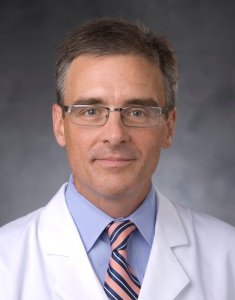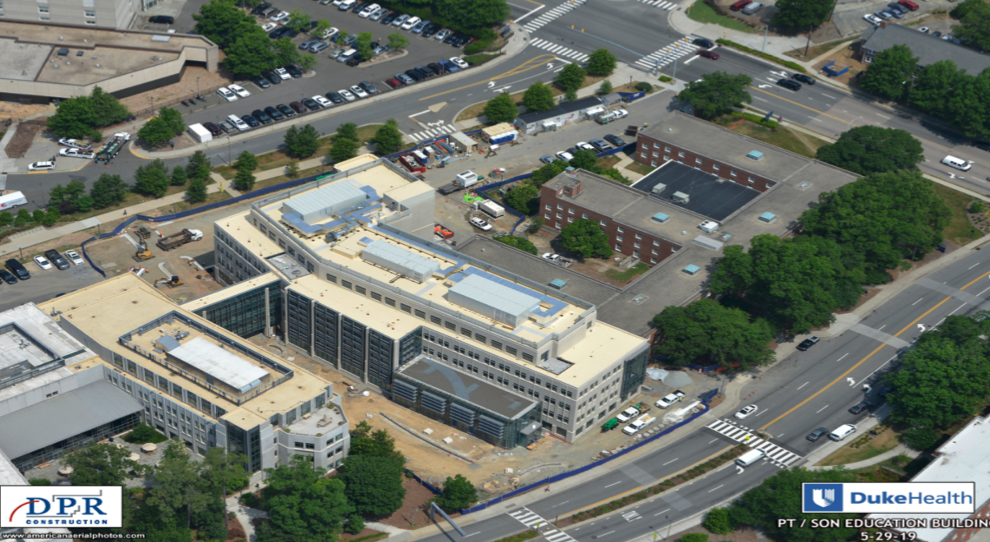
As the director of a new center at Duke dedicated to interprofessional education and care, Mitch Heflin, MD, MHS, professor of medicine (Geriatrics), expects to draw on his experience as a geriatrician.
“Interprofessional care is part of the core of geriatrics,” he says. “We embrace the model that says it takes a lot of different folks with different expertise working together. That’s the kind of work I’ve been doing in different settings and systems over the last 20 years.”
It’s routine for patients in a geriatric clinic or skilled nursing facility to be seen by a team of providers to address complex and interrelated needs. A good example is the team at the Durham VA Medical Center that works together to optimize outcomes for older people facing surgery. For the past four years, physicians, physician assistants (PAs), nurse practitioners (NPs), nurses, chaplains, physical therapists, pharmacists, psychologists, and social workers have met regularly and collaborated on patient care as part of the Perioperative Optimization for Senior Health (POSH) project.
Collectively, the team has the experience and expertise to support the needs of patients and help them prepare for a good surgical outcome. Some patients might need physical therapy before surgery, others might need to beef up their support system at home, others might need advice on how to avoid hospital delirium, and still others might need their medications evaluated. Some patients might even decide, based on their life goals, that the drawbacks to the surgery outweigh the benefits. A recent patient decided just that, while meeting with a team that included a doctor, an anesthesia PA, and a chaplain.

Mitch Heflin MD, MHS
Having seen how well this model works in geriatrics, Heflin is convinced its benefits have the potential for wider application.
“Good interprofessional care is not just a one-time interaction, and it’s not just that I’m able to describe your skills and how I refer to you,” Heflin says. “It describes how you and I concurrently see this person together and talk about it. My thoughts can be influenced by yours and yours by mine. We collaborate on care and we are both listening and learning.”
The interprofessional center will become official July 1, 2019.
“Our new center helps us significantly increase interprofessional education, research, and practice - a goal we articulated in our Advancing Health Together strategic planning framework,” says A. Eugene Washington, MD, chancellor for health affairs and president and CEO of the Duke University Health System. “And it will help us define new models for delivering the highest quality patient-centered care. Mitch Heflin’s experience in geriatrics and medical education, and his passion for interprofessional education and care, make him an outstanding choice to lead the center.”
The center will be located in a new building next to the School of Nursing, which is expected to be ready for occupancy in August. That location will encourage interprofessional (IP) interaction right off the bat, since it will house the Doctor of Physical Therapy Program, the Department of Orthopaedics, and the School of Nursing.
The center will focus on two goals: educating students from Duke’s different medical professional schools together, as well as increasing IP care in the health system as a whole. In Heflin’s mind, the two goals are intertwined. “Traditionally, we’ve been trained in silos and that’s reflected in how we practice,” he says. “We’re expected to work side by side but don’t always know how to work together, and part of that is that we’re not trained in proximity to each other.”
One of Heflin’s first projects is to inventory places where IP education or care is already succeeding at Duke, in Durham, and across the region. For example there is a clinic in the emergency room where groups of students from the School of Medicine, the School of Nursing, the Physician Assistant Program, and the Doctor of Physical Therapy Program work together to assess patients and create plans of care.
Another early priority is to identify faculty from each of Duke’s medical professional schools to work in the center.

The center will be located in a new building next to the School of Nursing, which is expected to be ready for occupancy in August.
Heflin will also be inviting students to get involved from the beginning. “The real impetus for this is going to come from the students themselves,” he says. “The generation of health professionals being trained now has a different way of seeing the world. They know this is what they need, so they are out there seeking it.”
Innovation, evaluation, and dissemination will be central to the mission of the new center, which Heflin hopes will not only transform education and care at Duke, but also to influence the conversation about IP education on a national level.
Evidence so far supports the idea that IP education and care result in better outcomes for students, providers, and patients. But there’s more to be discovered in the details of how it works and identifying the best models of delivery. How does IP education influence what students learn and how they feel about it? Does it influence what specialties they choose? How does IP care change the experience of patients? And how does it influence the experience of providers?
Based on his own involvement with interprofessional teams, Heflin believes IP care will improve the experience of providers. “IP practice is an important remedy for the things that contribute to burnout in my mind, feeling like we don’t have time, power, energy, or know-how to do things and feeling isolated in that endeavor,” he says. “Embedded in this is the power of the creativity that’s fostered by working in teams.”
When he looks to the future, Heflin sees the center generating positive outcomes for learners, faculty, and patients by supporting innovative IP education and care. “The ultimate vision is in five years, people come to Duke because they understand the relevance of this, and they understand how this is going to improve patient experience and their skills,” he says.
This article was written by Mary-Russell Roberson, a freelance writer for the Department of Medicine.